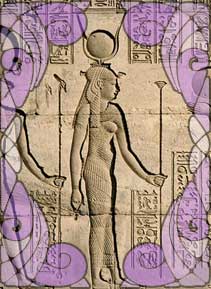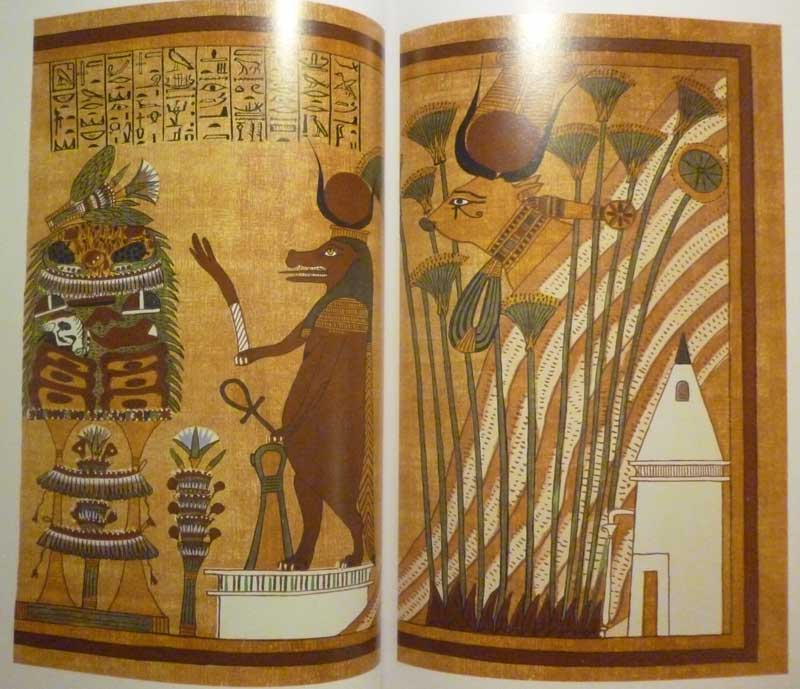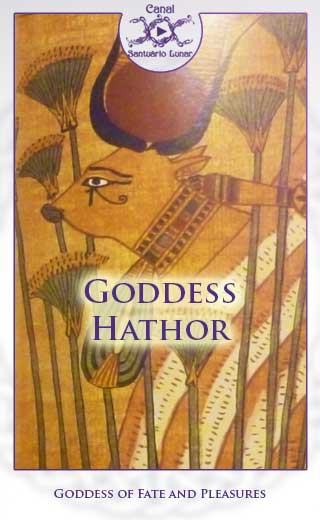Goddess Hathor is one of the most important Goddesses in Egypt. Her worship extends for more than 3000 years. She is usually depicted as a Cow and she is related to the destiny and to the pleasures of the flesh.
Due to the greatness of her worship (both territorial and temporal), it is common to see variations within her myth. Therefore, sometimes she is the daughter of the Sun God, Ra, and sometimes she is his mother. She is usually depicted as a Cow, but she can also be seen as a lioness (in which Hathor is an aspect of the Lioness Goddess Sekhmet), a fig tree or a date palm.

The Goddess Hathor is most commonly portrayed as a cow-headed woman with horns and large wings coming off her shoulders. This representation is somewhat similar to that of the Goddess Isis, and in this form, she is also responsible for giving birth to the universe.
- Attributes: Goddess of the sun, fertility, destiny, arts, love and earthly pleasures
- Symbols: Cow, lioness, sistrum (a rattle similar to the ankh), mirror
- Place: Egypt
Contents
Goddess Hathor – Goddess of fertility and pleasures
The Egyptians used to see the sky as the great belly of a cow and the sun was the light that passed through the span of its horns. Because of this association, Goddess Hathor was also associated with the fertility of the land and the people and was, therefore, worshiped as a Fertility Goddess.
Many texts refer to the Goddess Hathor as “The golden one“, the one that creates and strengthens the affective bonds. This is a fitting definition, for she was the patron of the pleasures of the body, including music, art, cosmetics, dance, and the sexual act. In this aspect, Hathor is also related to the Goddess Bast.
Goddess Hathor – Goddess of Fate
The Goddess Hathor ruled both birth and death and, thus, she was portrayed as “seven Hathor Goddesses”, responsible for predicting the inescapable fate of each newborn.
As the governess of the underworld, she was called the Queen of the West, the cardinal point associated with death. She accompanied her devotees on their final journey, so rituals to her devotion were commonly part of every funeral.

[su_spoiler title=”Click here to read a commentary about the plate above extracted from the Book of the Dead” style=”fancy” icon=”chevron”]We should consider this concluding scene to be a continuation of the preceding plate. The key element of the entire vignette is the unassuming representation of Ani’s tomb with its pyramidal top in the bottom right corner. At this point in the papyrus, Ani certainly has achieved the goal of the document and will soon be “going forth by day” through the doorway. The tomb is shown nestled against the Western Mountain of Thebes into which the tomb shafts were cut. Towering above the tomb the slope of the desert cliff, indicated by the striped and dotted pinkish soil.
The mountain is incongruously surrounded by a papyrus thicket. The papyrus stalks are connected not with the mountain, but with the goddess Hathor whose head is shown emerging from the slope. The thicket symbolizes the marshlands where the undomesticated cattle roamed in primordial times. The goddess’ eye is in the form of the wadjet-eye of Horus or Re, and she wears the menat-collar about her neck. Between her horns is a sun-disk surmounted by two ostrich feathers. In addition to her other attributes, Hathor became a major deity of the afterlife in the New Kingdom. At Thebes, she was particularly associated with the Western Mountain where the royal and private tombs were located. At Deir el-Bahri, the section of the Theban necropolis where the splendid mortuary temple of the eighteenth-dynasty Queen Hatshepsut was located, there was a cult of Hathor, who according to legend had appeared there in a cave. Hathor, then, is shown emerging into the light just as Ani hoped to do himself. This illustration is a striking testament to the allusive character of Egyptian religious art.[/su_spoiler]
Goddess Hathor – Goddess of Love
The Goddess Hathor was much loved in ancient Egypt, but she has a somewhat troubled story. At the beginning of her existence she was called “The Eye of the Sun” or “The Eye of Ra” and in this form, she was a Goddess of Destruction, the intense and strong Goddess Sekhmet.
According to legend, Ra, the Sun God, was no longer being respected by the people of Lower Egypt during his tenure as Pharaoh and he discovered that the people conspired against him. To solve this situation he decided to send his eye to deal with the matter.
The eye was the Goddess Sekhmet, who began to kill hundreds of people and drink their blood. When Ra asked her to stop, she simply ignored him. The God then had the idea of coloring red beer (to look like blood) and pouring into the battlefields.
Sekhmet became so drunk with the beer that she slept for three days and was purified in this process, losing the taste for blood and human flesh. Upon awakening, she showed a more loving and benevolent face, which is Goddess Hathor.
Goddess Hathor – Goddess of Nourishment
Originally the Goddess Hathor was a personification of the Milky Way, whose creation was considered to be from the milk that flowed from a divine cow. As time went by, Hathor absorbed the attributes of several other Goddesses and eventually got close to the Goddess Isis, who at some moment took her position as the most powerful and popular Goddess of ancient Egypt.
Summoning Goddess Hathor
The Goddess Hathor is a Goddess of many attributes and she can be summoned for different reasons, for example: When you feel in doubt which way to go in life; when you need to attract fertility; or when you need to attract happiness to yourself and to others…
Here is a simple ritual to thank and ask this Goddess:
Necessary Items
- A symbol of Hathor (Something that represents her, a statue, a mirror, a cow …)
- Scented oils and perfumes of your choice
- Incense if you wish
- Food and drink
Be in a quiet place where you rest. Take the chosen symbol, wash it and pass the oils and perfumes on it. While doing this, say words, recite poetry or sing songs of love, joy, affection…
When you finish, light the incense. Thank the Goddess for everything and make your wish. Keep the symbol somewhere safe and place an offering like foods, cake and fruits, drinks (beer or wine for example)…
After a few hours return and eat the offerings, Hathor has already withdrawn the energy she needed. Ask her to guide you on the path of the Goddess and thank her again.
Recommended readings:
[su_custom_gallery source=”media: 3364,3363″ limit=”5″ link=”custom” target=”blank” width=”140″ height=”170″ title=”never”]

Read about other Egyptian Goddess
[su_posts template=”templates/list-loop.php” posts_per_page=”0″ tax_term=”1031″ order=”asc” orderby=”title”]
